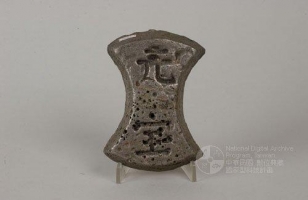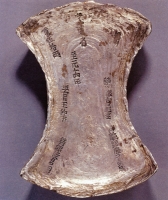|
Tags: currency | silver | Yuan dynasty
This provincial silver ingot, weighing more than nineteen hundred grams, was the official currency of the Yuan dynasty. As you can see, it is shaped like a flat weight. On the front of the silver ingot is engraved “provincial”, “fifty Liangs”, and the names of the officials that were responsible for the casting. Two characters, “Yuan Bao”, are engraved on the back. Silver has a long history in China. It was one of the currencies in the Spring and Autumn and Warring States period. There were four silver coins unearthed from the Chongshan site in Hepai Province. During the Han dynasty, silver coin was included in the official currencies, but it was limited to use by the royal family only. The economic traffic between the Plains and the Western territory was busy in the Tang dynasty, and the circulation of the silver became popular, such that more than four hundred silver “Kaicaijinbaos” were found in the basement of the Ho village in Xian.
There are a large amount of unearthed Song coins today, which means the coins in this period have been very popular. Nations such as Liao, Xixia, and Jin that had trade with China forced China to export silver, causing the government to collect silver. Paper notes became like waste paper, and the financial structure of the country collapsed. The silver coins “Chengan zhu bao” that were cast in Chengan during the second year of the Chang emperor of Jin, range from one liang to ten liang divided into five levels. Every two liangs of silver coins converts to the two guans of copper coins. This was the beginning of currency exchange in China. In the Yuan dynasty people also took silver ingots seriously and used them in large quantity. These are the “Yuan Bao” silver ingots that we are all so familiar with today. After the Ming dynasty, silver ingots become the main currency in circulation, until the end of Qing Dynasty, when the new silver coins made by machines replaced silver ingots as the main currency in circulation.

|

|
National Museum of History
|













